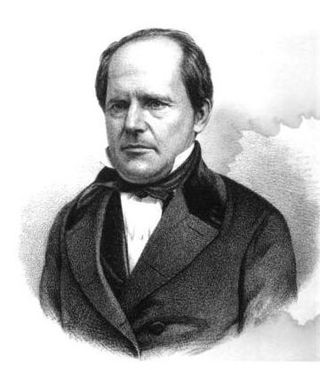
Matthew Lyon was an Irish-born American printer, farmer, soldier and politician, who served as a United States representative from both Vermont and Kentucky.

Isaac Tichenor was an American lawyer and politician. He served as the third and fifth governor of Vermont and United States Senator from Vermont.
These are tables of congressional delegations from Vermont to the United States Senate and United States House of Representatives.
William Strong was an American businessman and politician. He served two terms as a congressman from Vermont from 1811 to 1815.

The 1812–13 United States House of Representatives elections were held on various dates in various states between August 3, 1812, and April 30, 1813. Each state set its own date for its elections to the House of Representatives before the first session of the 13th United States Congress convened on May 24, 1813. They coincided with James Madison being re-elected president.

Israel Smith was an American lawyer and politician. He held a wide variety of positions in the state of Vermont, including as a member of the United States House of Representatives, a member of the United States Senate, the fourth governor of Vermont.

James Fisk was an American politician from Vermont. He served in the House of Representatives and the United States Senate.
Mark Richards was an American politician. He served as a member of the United States House of Representatives from Vermont and as the ninth lieutenant governor of Vermont.

Samuel Chandler Crafts was a United States representative, Senator and the 12th governor of Vermont.
William Cahoon was an American judge and politician. He served as a U.S. representative from Vermont for two terms from 1829 to 1833.

William Slade Jr. was an American Whig and Anti-Masonic politician. He served as a U.S. Representative from Vermont from 1831 to 1843, where he was an outspoken opponent of slavery. He was the 17th governor of Vermont.
Elias Keyes was an American politician and judge. He served one term as a U.S. Representative from Vermont from 1821 to 1823.

James Meacham was an American politician, minister and professor. He served as a U.S. Representative from Vermont from 1849 until his death.
Henry Shaw was a U.S. Representative from Massachusetts, son of Samuel Shaw.

Heman Allen was an American lawyer, politician and ambassador from Colchester, Vermont. He served as a U.S. Representative and as America's first United States Minister Plenipotentiary to Chile.
Augustus Young was an American politician. He served as a United States representative from Vermont, a member of the Vermont House of Representatives, state’s attorney for Orleans County, a judge of probate, a county assistant judge, and a member of the Vermont State Senate.
Vermont's 5th congressional district is an obsolete district. It was created in 1821. It was eliminated after the 1840 census. Its last congressman was John Mattocks.

Vermont gained two seats after the 1810 census. Rather than re-district, however, Vermont replaced its districts with a single at-large district. It would continue to use an at-large district in 1814, 1816, and 1818, then one more time in 1822.
This page is based on this
Wikipedia article Text is available under the
CC BY-SA 4.0 license; additional terms may apply.
Images, videos and audio are available under their respective licenses.










